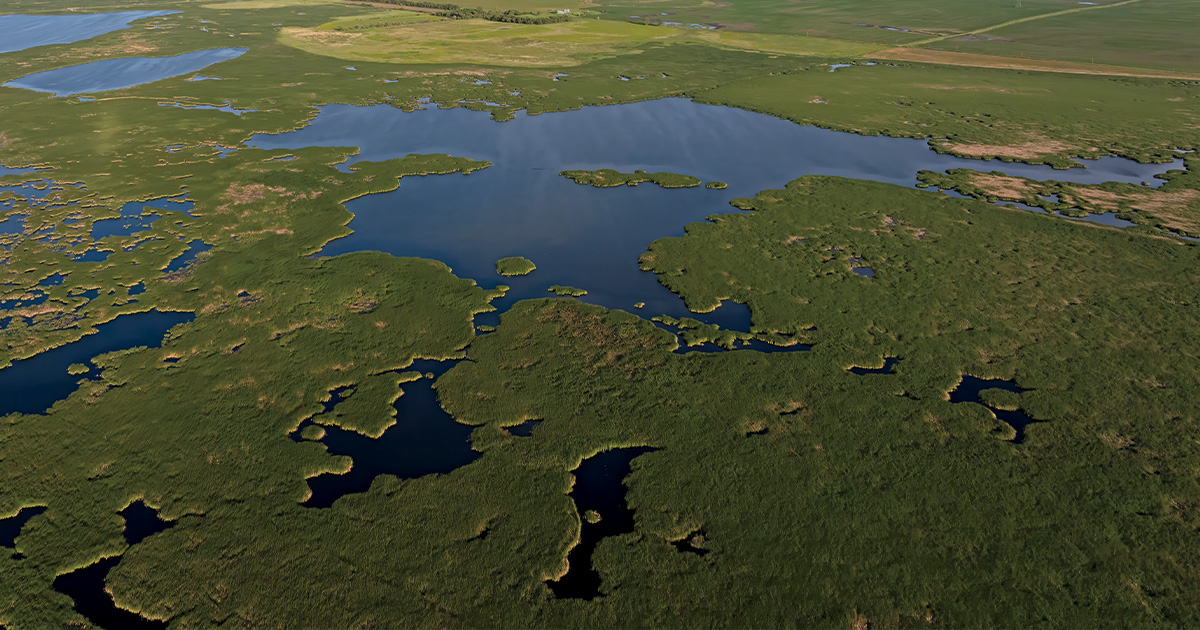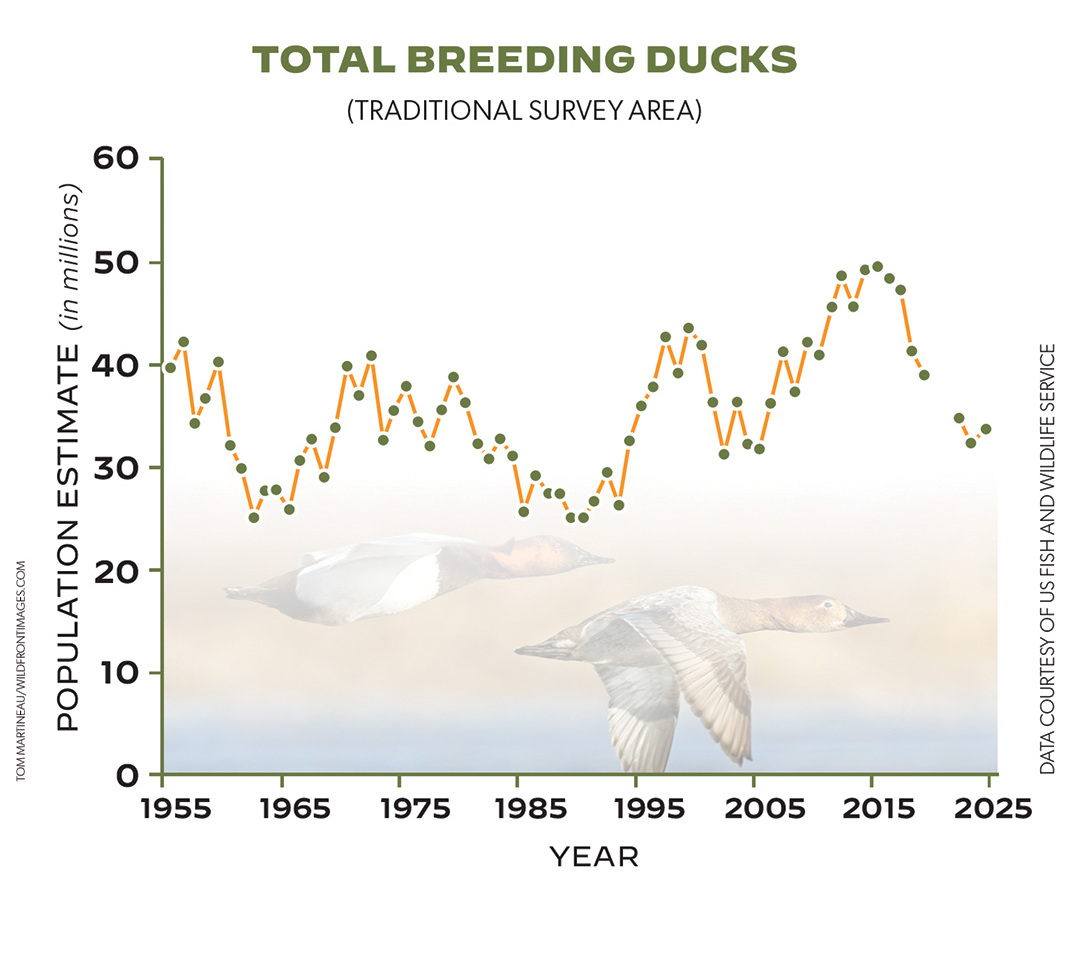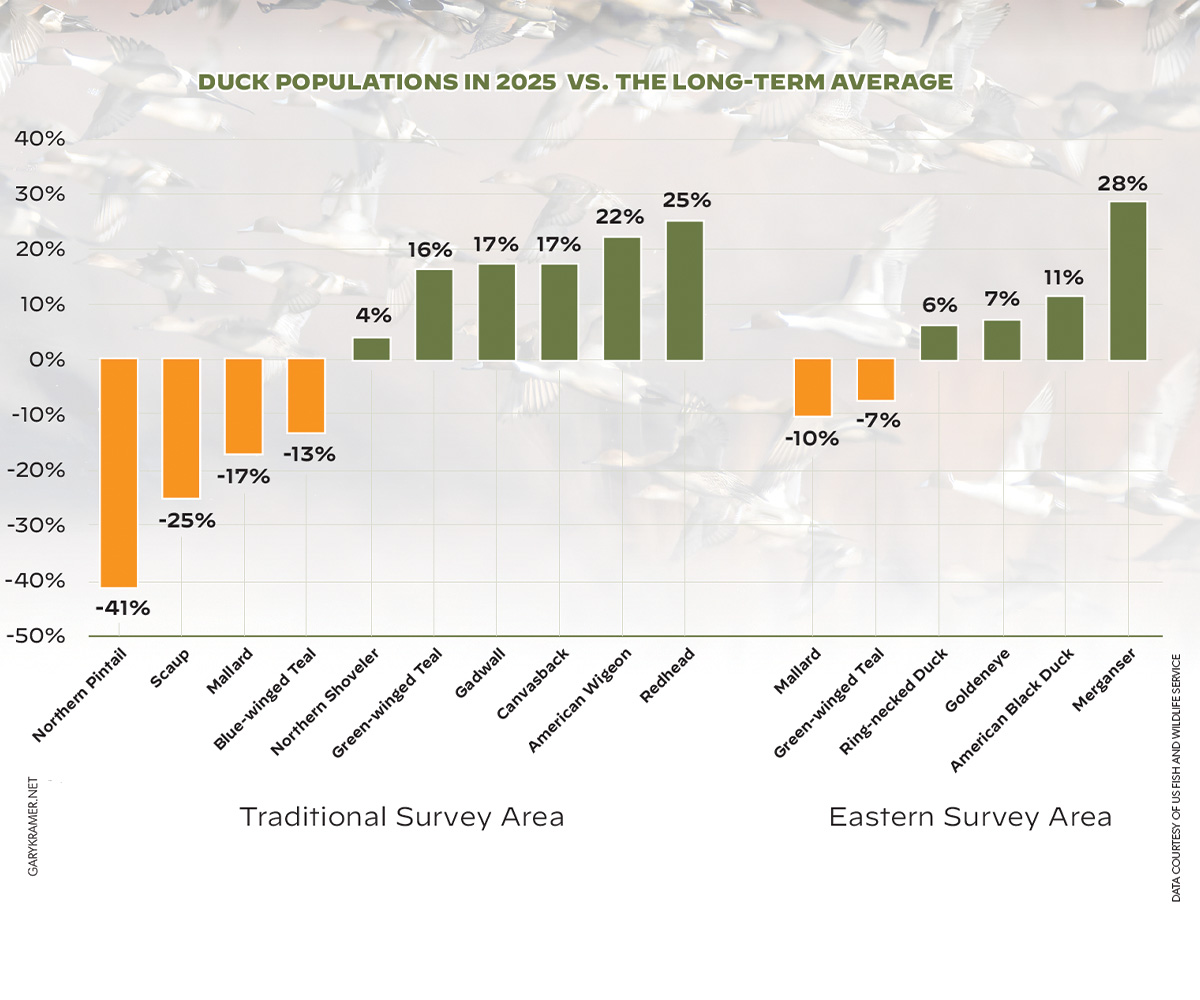DU Special Report: 2025 Status of Waterfowl
Duck populations held steady as drought intensified across midcontinent breeding areas
Duck populations held steady as drought intensified across midcontinent breeding areas
By Mike Brasher, PhD; John Coluccy, PhD; Scott Stephens, PhD

Despite modest gains in duck populations a year ago, there was little hope for continued increases going into 2025, as managers assumed that persistent drought across the prairies and Boreal Forest had limited duck production during the 2024 breeding season. These expectations largely held true, as the US Fish and Wildlife Service’s 2025 Waterfowl Population Status report was a virtual carbon copy of the 2024 report. Total duck numbers in the traditional survey area were essentially unchanged at 33.98 million birds, a level 4 percent below the long-term average.
Mallards also held steady at 6.55 million birds, which was among the lowest estimates in 30 years and 17 percent below the 1955–2024 average. The estimate for northern pintails was up 13 percent to 2.24 million birds, while blue-winged teal decreased 4 percent and were 13 percent below the long-term average. Estimates for other species increased or decreased modestly, reflecting the resiliency of North American duck populations.
“Waterfowl again demonstrated their adaptability despite relatively dry conditions in 2024, as late-nesting species capitalized on spring rains on the prairies and those that settled in the Boreal Forest held their own,” said DU Chief Scientist Dr. Steve Adair. “These flexible breeding strategies and use of continental habitat resources appear to have contributed to decent production last year, which carried over to a similar breeding population this spring.”
The status of North America’s waterfowl populations is largely driven by habitat conditions in the Prairie Pothole Region and other key breeding areas.
Hunters and biologists eagerly anticipate yearly reports about the size of the spring breeding population, but these numbers alone don’t define hunting prospects in fall and winter. Habitat conditions on the breeding grounds drive summer duck production and largely determine whether the fall flight will be filled with a strong cohort of young, naïve birds or consist mostly of experienced adults, which can frustrate even the most skilled hunters. Unfortunately, estimates of May ponds—an index of breeding habitat conditions in the US and Canadian prairies—foretell of challenging times ahead. The 2025 estimate of 4.18 million May ponds was down 19 percent—20 percent below the long-term average and the lowest estimate since 2004. Scattered rainfall in May and June brought minor improvements in wetland conditions for late-nesting species and renesting hens, but duck production was expected to be fair to poor across the prairies and Western Boreal Forest overall.
Meanwhile, duck populations and breeding habitats in the eastern survey area, which encompasses eastern Canada and the northeastern United States, remained healthy. Combined estimates for six common duck species and groups in this region decreased 7 percent but remained 6 percent above the 1998–2024 average. The estimate for eastern mallards was unchanged from 2024, while American black ducks decreased by 6 percent. Pilot-biologists reported another year of good to excellent habitat conditions across the eastern survey area, providing optimism for good duck production in the region.
The following sections highlight population estimates and habitat conditions of greatest relevance to hunters in each individual flyway.

Despite widespread drought on the prairies and in the Western Boreal Forest, American wigeon and many other species held their own this year, likely reflecting better-than-expected breeding success in 2024.
The annual fall flight encountered by Pacific Flyway hunters is largely derived from waterfowl breeding populations in Alaska, British Columbia, Alberta, and local areas of Washington, Oregon, and California. Total breeding duck estimates across these regions in 2025 were virtually unchanged from 2024 and remained 6 percent above the long-term average. However, total breeding ducks in Alaska remained 30 percent below the long-term average. Mallards declined 8 percent on northern breeding areas, with estimates in Alaska experiencing the greatest regional decline, dropping 23 percent from last year’s estimate but remaining at the long-term average.
Most notable were above-average breeding duck estimates in the portion of the Boreal Forest that spans central and northern Alberta and the Northwest Territories. For the second consecutive year, early migrants, such as mallards and pintails, overflew the drought-stricken prairies and settled in more northern breeding areas. Other species followed suit, including American green-winged teal, American wigeon, blue-winged teal, and redheads. Total duck estimates in this region were 44 percent above the long-term average, with individual species estimates ranging from 37 to 288 percent above average.
Total duck and mallard estimates in British Columbia, Washington, Oregon, and California either increased or were similar to last year, with California showing the biggest increases. Total breeding ducks in California were up 27 percent over 2024, and mallards increased by 49 percent. Although these estimates were significant improvements over those of recent years, total ducks and mallards remained 12 and 17 percent below their respective long-term averages.
Habitat conditions for breeding ducks across western regions varied, which likely resulted in variable waterfowl production in the Pacific Flyway. Intense drought persisted across much of central and northern Alberta, British Columbia, and the Northwest Territories, with some rivers and lakes reaching their lowest levels on record. Habitat conditions in other areas, such as Great Slave Lake, fared better and likely supported fair to good duck production. The spring thaw was early across Alaska, benefiting early nesters, but below-average snow cover and rainfall may have limited habitat for broods. Wetland conditions farther south also varied, from extremely dry in British Columbia to excellent in portions of Washington, Oregon, and California.
“While duck populations remained stable year over year in the Pacific Flyway, poor habitat conditions across much of the Western Boreal Forest raised concerns about waterfowl production in 2025,” noted Dr. Dan Smith, waterfowl scientist in DU’s Western Region. “Two bright spots included the 30 percent annual increase in pintail numbers in Alaska and record-high mallard counts coupled with excellent habitat conditions in northeastern California.”

Although wetland conditions deteriorated on many prairie landscapes, late spring and summer rainfall created pockets of good habitat in the Dakotas and parts of Alberta, where a strong waterfowl breeding effort was observed.
Estimates of total breeding ducks in areas of greatest importance to waterfowlers in the Central and Mississippi Flyways—including the Prairie Pothole Region, Western Boreal Forest, and Great Lakes region—were largely unchanged from 2024 and in line with the long-term average. Drought continued to influence waterfowl settling patterns across these regions. Although total breeding ducks increased by 20 percent on the Canadian prairies, these estimates were 20 percent below the long-term average. In contrast, estimates for the Western Boreal Forest decreased by 4 percent but continued to run significantly (27 percent) above the long-term average, indicating that many waterfowl overflew the prairies due to poor spring wetland conditions.
Northern pintails were a notable surprise, increasing by 13 percent across the traditional survey area. Most of this increase occurred in Alaska, northern portions of the Western Boreal Forest, and localized areas of the Canadian prairies. Estimates of species that nest primarily in the Boreal Forest were mixed. American wigeon increased by 9 percent, while American green-winged teal and scaup declined by 15 and 10 percent, respectively. The combined estimate for the five most common prairie-nesting dabbling ducks (mallards, pintails, blue-winged teal, northern shovelers, and gadwalls) was similar to that of 2024 and 15 percent below the long-term average. Redhead and canvasback estimates remained strong, increasing by 17 and 22 percent, respectively. Despite persistent drought across their core breeding ranges, these prairie-nesting diving ducks were 25 percent (redheads) and 17 percent (canvasbacks) above their long-term averages.

Unfortunately, wetland conditions worsened across the Prairie Pothole Region, with May pond counts declining 19 percent year over year to their lowest level since 2004. While the Canadian prairies received above-average winter snowfall, much of the moisture had soaked into the parched soil by the time spring arrived. This year’s estimate of 2.5 million May ponds in Prairie Canada was down 5 percent from 2024 and 27 percent below the long-term average. Nevertheless, May ponds in the region remained well above the record low of 1.4 million ponds observed in 2002. The steepest decline occurred on the US prairies, where pond counts dropped 34 percent to 1.6 million—a level 6 percent below the long-term average. Scattered rains in May and June provided localized improvements in wetland conditions on the prairies, but the precipitation arrived too late to benefit early nesters. Farther north, drought returned to large portions of the Boreal Forest, resulting in variable breeding habitat conditions and fueling another active fire season.
Hunters in the Mississippi Flyway also benefit from ducks produced in the Great Lakes states of Minnesota, Wisconsin, and Michigan. Estimates of total ducks and mallards across the Great Lakes declined by 23 and 21 percent, respectively, with much of the decline occurring in Michigan. In Wisconsin and Minnesota, mallard numbers increased by 27 and 16 percent, respectively. In Michigan, total ducks and mallards were down 79 and 65 percent, respectively, possibly due to survey anomalies. Wetland conditions varied across the Great Lakes this spring, with Minnesota suffering widespread drought, while good to excellent wetland conditions prevailed in much of Wisconsin and Michigan.
Total duck production in the Mississippi and Central Flyways is expected to be below average in 2025, likely resulting in another fall flight composed largely of well-educated adult birds. However, some bright spots existed, as field biologists in the US and Canadian prairies observed fair numbers of broods in areas with good habitat.

In the eastern survey area, American black duck numbers were down 6 percent from last year’s estimate but were 11 percent above the long-term average.
Waterfowl breeding habitats in eastern portions of the United States and Canada once again supported stable duck populations in 2025. The combined estimate of the six most abundant duck species in the eastern survey area was 4.8 million birds, a 7 percent decline from 2024 but 6 percent above the long-term average. Ring-necked ducks increased 9 percent and were 6 percent above the long-term average. Goldeneyes and green-winged teal each declined by approximately 25 percent. American black ducks were down 6 percent from 2024 but were 11 percent above the long-term average.
Breeding populations of mergansers, mallards, and wood ducks were largely unchanged from 2024. The total estimate for breeding mallards, which includes birds surveyed in eastern Canada and northeastern states from Virginia to Maine, was 1.14 million birds—similar to last year’s estimate but 10 percent below the long-term average. Wood ducks are an important quarry for many Atlantic Flyway waterfowlers, but their use of heavily forested wetlands makes them difficult to survey. A model-based estimate using multiple data sets indicated that the 2025 breeding population of wood ducks in the Atlantic Flyway was approximately 900,000 birds, similar to the previous year’s estimate and the long-term average.
Another year of good to excellent wetland conditions was reported across eastern Canada, setting the stage for good waterfowl production in this region. As the breeding season unfolded, numerous Canada goose, black duck, and mallard broods were observed by DU field staff. Breeding habitat conditions in the eastern United States received a boost from repeated soaking rains, which should have benefited breeding mallards. In general, duck production across much of eastern North America was expected to be average to good.
“Compared to other regions, like the prairies, wetlands on waterfowl breeding areas in the Atlantic Flyway are influenced less by seasonal variation in precipitation,” noted Sarah Fleming, DU’s managing director of conservation programs in the northeast region. “Although duck populations in the Atlantic Flyway are less abundant than in other flyways, they are more stable from year to year, and that pattern held in 2025.”

The outlook for snow and Ross’s geese was generally positive in 2025 as most light goose populations showed healthy increases and were expected to have good breeding success.
Additional surveys and methods are used to measure North American goose and swan populations. Notable increases were recorded for six of the 21 goose populations for which annual estimates are calculated. These include the Atlantic Population of Canada geese (+68 percent), dusky Canada geese (+45 percent), Ross’s geese (+217 percent), midcontinent lesser snow geese (+71 percent), midcontinent greater white-fronted geese (+115 percent), and emperor geese (+29 percent). The population estimate for greater snow geese declined 32 percent, while all others were statistically unchanged.
The timing of the spring thaw was early or average across most subarctic and arctic goose breeding areas in 2025, while a late spring was reported in northern Alaska, the western Canadian arctic, and the Ungava Peninsula of Quebec. In the Pacific Flyway, biologists reported a good nesting effort on Alaska’s Yukon-Kuskokwim Delta. Unfortunately, poor production is expected for Pacific brant due to high predation by arctic foxes and a poor nesting effort along the Colville River of Alaska due to a late spring thaw and flooding.
In the Central and Mississippi Flyways, breeding success among populations of lesser snow, Ross’s, cackling, and white-fronted geese was expected to be average or better. Reports from Banks Island in the western arctic suggested average production of snow geese, while fair to above-average production was reported for most species in the central arctic. Productivity on Baffin and Bylot Islands in the eastern arctic was also reported as above average, with Atlantic brant noted as having an excellent production year. Spring arrived late on the Ungava Peninsula, resulting in poor breeding prospects for Atlantic Population Canada geese despite the significant increase in goose numbers.
“Based on reports from banders, goose production in arctic and subarctic breeding areas was generally good in 2025,” reported Frank Baldwin, a wildlife biologist with the Canadian Wildlife Service. “Midcontinent goose hunters should expect above-average numbers of juveniles in the fall flight of snows, cacklers, Ross’s, whitefronts, and subarctic-nesting Canada geese. Pacific Flyway hunters can expect average or better production of snow geese, but below-average production of Pacific brant. Atlantic Flyway hunters can expect a bumper crop of Atlantic brant and greater snow geese but below-average production of Atlantic Population Canada geese.”

Despite recent declines in waterfowl populations, history and science remind us that these birds are remarkably resilient. Thanks to our continental approach to conserving waterfowl habitats, ducks are proving their ability to endure difficult times. Although some species face unique challenges and now rely on landscapes that have suffered significant losses of habitat and productivity, the overall picture is encouraging. As we approach nearly a decade of drought on the prairies, 10 of the 16 waterfowl species or species groups surveyed across the traditional and eastern survey areas remain at or above their long-term averages.
Waterfowl populations, managers, and hunters have endured lean times before, and duck hunters of the future will also tell stories of cyclical drought and times of low populations. But the depth of those declines and future opportunities to spend time with friends and family in the blind will depend heavily on the conservation work we deliver today. Pressures facing waterfowl and their habitats are increasingly diverse and accelerating with each passing year. The good news is that our scientists and conservation-delivery experts have identified the issues that limit waterfowl populations and are working diligently to provide solutions.
“The continued loss of wetlands and grasslands in the Prairie Pothole Region is the most significant threat to North America’s waterfowl,” said DU CEO Adam Putnam. “While DU works across the continent to ensure that waterfowl have adequate habitat across their entire life cycle, the prairies remain our highest conservation priority. Meeting the challenges on this landscape requires strong public policy and broad partnerships. Conservation is a long game. Together, we are working to ensure that when the rains return, protected habitat is there to receive it and sustain abundant waterfowl for generations to come.”

Canvasbacks were a notable bright spot in this year’s survey results, posting a 22 percent increase from the 2024 estimate.
In positive news, reports from the prairies indicate that the early ingredients for improved wetland conditions and rebounding waterfowl populations may be taking shape. Widespread rainfall during late summer improved soil moisture and provided at least a temporary break from drought across the US and Canadian prairies. However, a good frost seal and heavy winter snowfall or spring rains will likely be needed to make significant progress in refilling wetlands and reversing the effects of prolonged drought. Despite lingering gray clouds, we join our fellow hunters in heading outside this fall to enjoy this wonderful resource, knowing that each new day brings the opportunity to make memories that will be cherished for years to come.
In closing, we thank our partners in the US Fish and Wildlife Service, Canadian Wildlife Service, and state agencies with the Atlantic, Mississippi, Central, and Pacific Flyway Councils for their ongoing leadership in conducting the Waterfowl Breeding Population and Habitat Survey, banding programs, harvest surveys, and other data-collection efforts that serve as the lifeblood of science-based waterfowl management in North America. Continuation of these efforts and the stability they bring to our waterfowl hunting pastime is possible only with your steadfast support and participation. We encourage all DU members to embrace opportunities to engage in these efforts for the benefit of waterfowl and our waterfowling traditions.
Ducks Unlimited uses cookies to enhance your browsing experience, optimize site functionality, analyze traffic, and deliver personalized advertising through third parties. By continuing to use this site, you agree to our use of cookies. View Privacy Policy